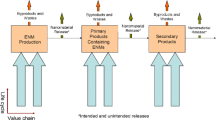Abstract
Nanomaterials promise to transform commercial products, providing significant societal benefits. As the nanomaterials enterprise grows, so too, does the debate over environmental, health, and safety (EH&S) aspects of producing them. This article discusses nanomaterial EH&S needs and progress being made by industry, academic institutions, and government laboratories.
Similar content being viewed by others
References
K. Zappas, JOM, 59(12) (2007), p. 72.
“The National Nanotechnology Initiative Research: Research and Development Leading to a Revolution in Technology and Industry,” Supplement to the President’s FY 2008 Budget (Washington, D.C.: National Science and Technology Council, 2007).
G.M. Holdridge, “National Nanotechnology Initiative: Overview and Commercialization Efforts” (Presentation at the Commercialization of NanoMaterials 2007, Pittsburgh, PA, 12 November 2007).
C. Rohrer and T.M. Osman, “Nanotechnology in Materials Science and Engineering Education,” Materials Technology@TMS (November 2007), materialstechnology.tms.org/TECpage.asp.
T.M. Osman et al., JOM, 58(4) (2006), pp. 21–24.
NATO Science for Peace and Security Series-C: Environmental Security, ed. P.P. Simeonva, N. Opopol, and M.I. Luster (New York: Springer, 2007), pp. xi–xv.
A.D. Maynard, NATO Science for Peace and Security Series-C: Environmental Security, ed. P.P. Simeonva, N. Opopol, and M.I. Luster (New York: Springer, 2007), pp. 1–14.
Environmental, Health and Safety Research Needs for Engineered Nanoscale Materials (Washington, D.C.: National Nanotechnology Coordination Office, August 2006).
V.L. Colvin, “Research on Environmental and Safety Impacts of Nanotechnology: Current Status of Planning and Implementation under the National Nanotechnology Initiative,” Testimony to the United States House of Representatives Committee on Science and Technology (31 October 2007).
Nanotechnology Recent Developments, Risks and Opportunities, Lloyd’s Emerging Risk Team Report (London: Lloyds, 2007).
S. Wood, R. Jones, and A. Geldart, “The Social and Economic Challenges of Nanotechnology, Economic and Social Research” Swindon, U.K.: Economic and Social Research Council, 2005).
P.A. Schulte and F. Salamanca-Buentello, Environ. Health Perspect., 115 (January 2007), pp. 5–12.
A. Maynard, Is Engineered Nanomaterial Exposure a Myth? (Safenano, U.K.: 2 October 2007).
K.R. McDonald, “Nanomaterials: An HSE Overview” (Presentation at the Commercialization of NanoMaterials 2007, Pittsburgh, PA, 12 November 2007).
R. Ogle, “Application of Industrial Hygiene Tools and Tenets to Controlling Nanomaterials in R&D Operations” (Presentation at the Commercialization of NanoMaterials 2007, Pittsburgh, PA, 12 November 2007).
E. McMeekin, “Environmental and IH Considerations in Nanomaterial Production and Use” (Presentation at the Commercialization of NanoMaterials 2007, Pittsburgh, PA, 12 November 2007).
K. Rickabaugh, “Laboratory Workplace Safety Practices and Sampling and Analysis Considerations” (Presentation at the Commercialization of NanoMaterials 2007, Pittsburgh, PA, 12 November 2007).
H.S. Matthews, “Life Cycle Impacts of Nanotechnology” (Presentation at the Commercialization of NanoMaterials 2007, Pittsburgh, PA, 12 November 2007).
R. Shaffer, “An Overview of NIOSH Nanotechnology Research and an Update on the Efficacy of Personal Protective Equipment for Reducing Worker Exposure to Nanoparticles” (Presentation at the Commercialization of NanoMaterials 2007, Pittsburgh, PA, 12 November 2007).
“Final Nanotechnology White Paper” (Washington, D.C.: United States Environmental Protection Agency, 15 February 2007).
C. Geraci, “The NIOSH Nanotechnology Research Program” (Presentation at Commercialization of NanoMaterials 2006, 20 September 2006).
“Critical Topic Areas” (Washington D.C.: NIOSH, 2007).
“FDA Nanotechnology Task Force Report” (Washington, D.C.: United States Food and Drug Administration, 1 July 2007).
C.M. Garner, “ICON NanoEHS Research Roadmap Proposal” (Houston, TX: International Council on Nanotechnology, 10 May 2006).
P.D. Zeigler, “Nantechnology: Managing EH&S Issues and Regulations with an Emerging Technology” (Presentation at Commercialization of NanoMaterials 2006, 20 September 2006).
“Recommendations from the Toxicology Working Group of the Nanotechnology Panel of the American Chemistry Council for a Reasoned Approach to the Testing of Nanoscale Materials” (Arlington, VA: American Chemistry Council, 2006).
“Evaluation of the Health Hazard and Recommendation for Occupational Exposure to Titanium Dioxide,” NIOSH Current Intelligence Bulletin (Washington, D.C.: NIOSH, 22 November 2005).
B. Karn and H.S. Matthews, IEEE Spectrum (September 2007), pp. 55–58.
“Tool for the Reduction and Assessment of Chemical and Other Environmental Impact (TRACI)” (Washington, D.C.: United States Environmental Protection Agency, 2007).
“ANSI Nanotechnology Standards Panel” (New York: ANSI, 2007).
“Committee E56 on Nanotechnology” (West Conshohocken, PA: ASTM, 2007).
“Approach to Nanomaterials ES&H,” Revision 2 (U.S. Department of Energy Nanoscience Research Centers, June 2007).
“Approaches to Safe Nanotechnology: An Information Exchange with NIOSH,” Version 2.0 (Washington, D.C.: NIOSH, 2006).
“Progress Toward Safe Nanotechnology in the Workforce,” Publication 2007-123 (Washington, D.C.: NIOSH, 2007).
“Prudent Practices in the Laboratory Handling and Disposal of Chemicals” (Washington, D.C.: National Research Council, National Academies Press, 1995).
“Nanotechnology Consensus Workplace Safety Guidelines” (Washington, D.C.: ORC Worldwide, 2005).
“A Survey of Current Best Practices in Nanotechnology” (Houston, TX: International Council on Nanotechnology, 13 November 2006).
“Current Knowledge and Practices Regarding Health and Safety in the Nanotechnology Workplace” (Houston, TX: International Council on Nanotechnology, 18 October 2006).
“Nano Risk Framework” (Environmental Defense-DuPont Nano Partnership, June 2007).
Author information
Authors and Affiliations
Corresponding author
Rights and permissions
About this article
Cite this article
Osman, T.M. Environmental, health, and safety considerations for producing nanomaterials. JOM 60, 14–17 (2008). https://doi.org/10.1007/s11837-008-0025-z
Published:
Issue Date:
DOI: https://doi.org/10.1007/s11837-008-0025-z




